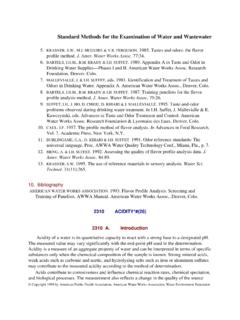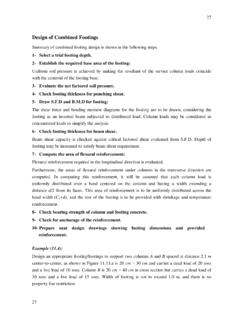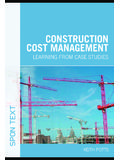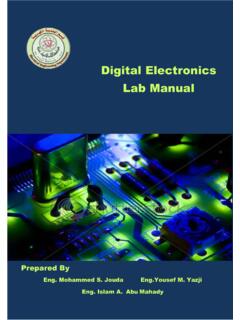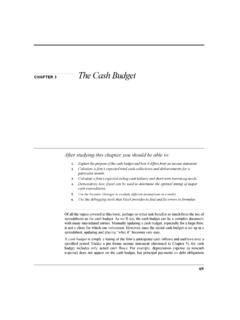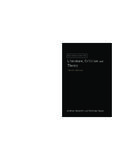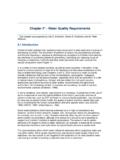Transcription of Marine Pollution - Islamic University of Gaza
1 0 Marine PollutionMain Reference: Marine Pollution1stedition 2013 Dr. Geert PottersISBN 978-87-403-0540-1 Available online: reference: Marine pollution5thEditionClark, (2002):Oxford University Press1 Contents1 What is Pollution ? Classification of Pollution Read more?2 How to measure Pollution Measuring Pollution is more difficult than you Measuring toxicity the classical Using biological responses as a marker for Molecular effects: single Modern technology: Modifications to tissues and Biomarkers on the organismal Effects on Read more?3 Inorganic pollutants Inorganic nutrients and Carbon dioxide and ocean Metal Read more?4 Oil and organic The polluting organic Oil Polycyclic aromatic Halogenated Read more?5 Newer forms of Noise Pollution : the death of a thousand Hitching a ride: invasive Read more?6 Policy and The How and Why of Pollution : The Tragedy of the The Oceans as International Convention for the Prevention of Pollution from Ships (MARPOL) MARPOL 73/78: it all started with oil Pollution The MARPOL Annexes: beyond oil Read more?
2 21 What is Pollution ? DefinitionsContaminationis,sensu stricto, used to describe the fact thata certain chemicalcompound is present in a certain habitat and/or the organisms living there, at aconcentration higher than normal or the background value, and this due to then be defined as any form of contamination inan ecosystem with aharmful impact upon the organisms in this ecosystem, by changing the growth rateand the reproduction of plant or animal species, or by interfering with humanamenities, comfort, health , or property values. In a broader sense, the termscontamination and Pollution also include any physical modification that alters theenergy or radiation flow in an environment (such as a heat source or a radioactiveelements), or even the presence of an invasive , Marine Pollution as defined by the Group of Experts on the Scientific Aspectsof Marine Pollution (GESAMP), as part of the basic framework of the UNConvention on the Law of the Sea (UNCLOS) 1982 (Article ), is: the introduction by man, directly or indirectly, of substances or energy intothe Marine environment (including estuaries) resulting in such deleteriouseffects as harm to living resources, hazards to human health , hindrance tomarine activities including fishing, impairment of quality for use of sea water,and reduction of amenities.
3 Classification of Pollution formsPollutants can be classified in different ways. First of all, they can be distinguishedaccording to their physicochemicalconstitution. Some areinorganic compounds (like the atmospheric pollutants NO,NO2, and SO2 or like metal ions); other types of Pollution are moreorganic in nature (like wastewater,the nitrogen and phosphorus-laden run-off of agricultural land orpetroleum derivatives). Newer forms are evennot chemical in origin (sound, light). Thephysical stateis another parameter to distinguish between differentpollutants. Some types are found insolid form, such as the plastic debris, but alsothe remains of sludge after bagger works. Other types are found in the atmosphere, either asdrifting solids(flying ashes, heavy metals adhering to dust particles and particulatematter), or asgases (like volatile organic compounds). Rivers will carry a number ofsolutes (nitrogen fertilizers, agriculturalrun-off,remains of antibiotics,medication and hormones).
4 A third way to classify pollutants usestheirpersistencein the environment. Some pollutants arebiodegradable ( , they will be mineralized bybacteria or otherwise assimilated in the metabolism of any of theorganisms in the environment) and thereforewill not continue to exist3in the ecosystem for a long time, cooking waste, sewage andmanure. Other pollutantsdissipatespontaneously (rapidly)and lose , discharged with the cooling water of a power station; and bases, due to the buffering capacity and the largevolume of the ocean in which they end up; , produced in metallurgical industries, also dissociateand dilute quickly in seawater (with only the immediateneighborhood of the discharge feeling negative effects of thepoison). A third group of pollutants areconservative or arenot subject to bacterial attack and are not dissipated, but are reactive invarious ways with plants and animals causing harmful metals (mercury, copper , lead, zinc and so on) sources, in the atmosphere, dioxins and more so, apolar pollutants usually display a tendency tobioaccumulate, animals at highertrophic levels accumulatesignificantly higher levels of these chemical compounds.
5 Lastly, Pollution can be classified aspoint source or nonpoint sourcepollution. Point source Pollution can be traced back to a single, identifiable spotwhere the pollutant originated for example, a sewage pipe from acompany, the noise from a windmill or the leak of the Deep Horizonoil drilling platform. Nonpoint source Pollution cannot be attributed to a specific locationor time, and has a rather diffusesource. Examples compriseagricultural runoff, dust from strip mining, or urban storm source Pollution is the leading cause of waterpollution in the United States today, with pollutedagricultural runoffthe most important sourceand nonpoint source pollution4 Table , sources, and effects of Marine SourcesOverall, the Pollution that ends up in the seas and oceans, originates fromfourdistinct sources. As represented in Figure 1-1, the major part of all Pollution comesfrom the land, either through run-off and discharges (via waterways; 44%) or throughthe atmosphere (33%).
6 Only 12% of all Pollution is due to maritime activity andshipping accidents. Dumping of garbage and sewage, as well as the consequences ofoffshore drilling and mining make up for the rest (resp. 10% and 1%).Figure of the different sources of Pollution into the Marine environment (After IMO 2012) Runoff from the landThe main transport of pollutants from the land to the sea occurs, evidently, throughrivers. Rivers take up different forms of waste material from the land, which ends upin the oceans. The most direct load of pollutants comes from the urban and industrialsewage systems that are dumped in the rivers, often preceded by a sanitation step in awater sanitation installation (and even more oftennot).This urban andindustrial runoff, together withagricultural run-off, also containshigh levels of nitrogen and phosphorus. These two elements are essential for plant life(and in fact, for the establishment of any food chain in any ecosystem on theplanet),but are often only present in the ocean in a limiting concentration to allow forabundant organismal growth.
7 A constant influx of nutrient-rich water from the landcan therefore upset any balance in the aquatic ecosystems in coastal areas. As thelevels of nitrogen and phosphorus rise, the microalgae populations find themselvesless and less restrained in their often results in so-calledalgal blooms:massive growth of the unicellular algae in the sea. When they die, the remainingbiomass is mineralize by bacteria, which thereby consume so much oxygen that thewater beneath these blooms becomes anaerobic. Any fish or invertebrate life there isbound to die. Hence, the so-calledeutrophication due to the influx of nutrients isbound to cause severe distortion to the balance of the Marine third source is the runoff fromdustparticles coming from metal ore and metalmines, washing away in the rivers. These metals can then wreak havoc with thenormal metabolism of plant and animal life.
8 According to the US EnvironmentalProtection Agency (EPA), over 40% of watersheds in the western continental UShave been contaminated with metals. A large proportion thereof ends up in , there are the large chunks of plastic that are being dumped along the coast,in rivers, Once they arrive in the ocean, they float along on the oceanic gyreswhich concentrates this kind of debris in the different oceans. This waste material isthe main killer of life in the ocean and maytake up to 450 years to be of Pollution into the Marine Atmospheric Pollution from the landThe atmosphere is another way for pollutants to reach the ocean. Lighter dust fractions and debris willbe takenup by the wind and blowntowards the ocean. A great number of dust particles will carry metaltraces, whichare spread out this way. A second type of atmospheric Pollution which affects the Marine environment arethegreenhouse gases,which, by warming the earth, also raise the temperaturesin the oceans.
9 A secondary consequence seemsto be that the increasedconcentration of CO2 in the atmosphere contributes to ocean acidification. Thirdly,combustion processes (like car engines) produce a significantamountof SO2 and NOx as well. These will increase the occurrence of acid ShipsShipping activity may pollute the atmosphere in two major ways (Figure 1-4): Ship s engines as well as the incineration of garbage:first of all, ship senginesas well as the incineration of garbage produce CO2, SO2 and NOx, whichwill add to global warming andacid rain formation. Furthermore,cooling systems may still be operating on freons andotherchlorofluorocarbons, and occasionally some halon gases(fire extinguishingagents which are gaseous when discharged) are still at hand for fighting accidental release and subsequent escape of these gases to thestratosphere furthers the build-up ofchlorofluorocarbons(CFCs) in the ozonelayer and the degradation of the latter.
10 It needs to be said, though: in many7instances,these gases are being traded in for more environment friendlyalternatives. Most ofmarinepollutionis simply by accident: When it comes to the amountof Pollution that goes into the water, it needs to be said thatmost of it is simplyby accident. As there are a good number ofinternational regulations that forbidexpress dumping of all different kinds of waste above certain , garbage has to be either delivered to shore or burnt in incineratorsonboard. Incinerationis prohibited in special areas (MARPOL Annex V).The quantitatively largest aquatic form of accidental Pollution (Figure 1-4)caused by the maritime sectoris also the one that has been highlighted the most:oil spills. As crude oil consists of a wide range ofdifferent hydrocarbonmolecules with different molecular weight and properties, it is not easy to give aconcise view of the total damage that is done by an accidental spill.
